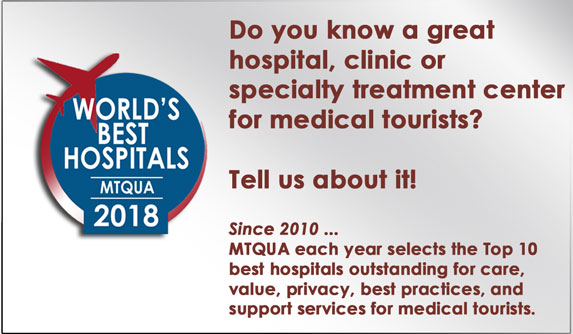 A tourist books a holiday at a hotel advertising a seaside location and ocean view. Upon arrival, the tourist finds the sea is across a highway and down a cliff from the hotel. The ocean can only be viewed from a few rooms on the highest floor of the hotel.
A tourist books a holiday at a hotel advertising a seaside location and ocean view. Upon arrival, the tourist finds the sea is across a highway and down a cliff from the hotel. The ocean can only be viewed from a few rooms on the highest floor of the hotel.
Yes, it is technically by the sea but not as advertised in the brochure and on the web. The tourist complains and seeks compensation, as a discount, a free meal or extra nights. Or the tourist finds a different hotel. The following year, when the tourist repeats his seaside holiday, he will be sure to stay elsewhere.
There are no do-overs for medical travelers
A medical traveler does not have the opportunity to “try out” a hospital or doctor and, if unsatisfied, find a different one. The medical traveler has one shot at getting it right. There are no do-overs.
Medical travelers have 3 common characteristics
- They are not resident in the destination country
- They travel from home to a different country for care
- The cultural or social environment and/or language of the medical destination is often different or strange
They are traveling international patients.
Are all expatriates or international patients medical travelers? Is medical tourism the same as health tourism? Is it the same as global health care? Read What Is Medical Tourism? from the Medical Travel Quality Alliance publication, for a practical understanding of what is and is not medical tourism.
When medical travelers choose to have medical treatment in another country, we can say they are going on a medical travel journey. Calling it a medical holiday underestimates the seriousness of the trip, and is close to misleading the medical traveler into believing the journey may be without extraordinary risk.
Features of a medical travel journey
A medical travel journey, defined as a trip taken for the purpose of having a medical procedure, is typically distinguished by the following:
- Advance planning
- Exchange of medical records and medical history
- Pre-surgery instructions that may need to be followed prior to reaching the medical destination
- A procedure that is invasive and/or requires general or twilight anesthesia; or is a major non-invasive treatment (chemotherapy, radiation therapy, etc.)
- Recovery care management including medical monitoring and consideration about post-surgery accommodations
- Care planning and follow-up upon returning home
- Possible additional, unexpected medical attention
Unexpected medical attention is an important consideration since the medical traveler may acquire an infection, get a complication, or have a bad outcome, likely needing further medical care either at the medical destination or at home.
Medical travel involves invasive procedures
It is critical to make a distinction between invasive and non-invasive procedures. Insurance companies that issue medical travel insurance are clear about this, covering the risk of complications from most invasive procedures. They don’t cover non-invasive procedures since there is very little risk to the patient from them.
Non-invasive procedures are dental treatments (excluding implants), dermatology procedures, certain cosmetic procedures, some ophthalmology procedures, genetic testing and so on. European spas traditionally provide healing waters and mineral baths, and are prescribed by medical doctors for rehabilitation.
The U.S. government defines surgical and other invasive procedures as operative procedures in which skin or mucous membranes and connective tissue are incised, or an instrument is introduced through a natural body orifice. Invasive procedures encompass a range of services, including:
- Minimally invasive dermatological procedures (e.g., biopsy, excision, or deep cryotherapy for malignant lesions)
- Extensive multi-organ transplantation
- All procedures classified as surgery
- Procedures such as percutaneous transluminal angioplasty and cardiac catheterization
- Minimally invasive procedures involving biopsies or placement of probes or catheters requiring entry into a body cavity through a needle or trocar
Some very minor procedures such as drawing blood or using certain instruments for examinations are technically invasive procedures but are not included in the definition.
What Is Medical Tourism? a Best Practices in Medical Tourism publication from MTQUA, is available to download here.

 >
>